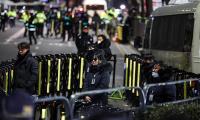The global community has spent almost three decades trying to prevent the Kim regime in North Korea from moving its fingers towards the nuclear button, but it has failed to achieve the goal. Whether we like it or not, North Korea has achieved the status of a full-fledged nuclear power.
Siegfried Hecker, an American nuclear scientist and metallurgist who has visited North Korean nuclear facilities more than five times, believes that the country has 25-30 nuclear warheads in its arsenal. However, according to other intelligence estimates, the number of weapons is believed to be above 50.
The Kim regime has also conducted a test of an intercontinental ballistic missile, demonstrating its ability to hit the United States with a nuclear weapon. Last month, Pyongyang launched its most powerful ballistic missile, the Hwasong-15, which has an estimated range of 13,000 km. More alarmingly, the Hwasong-15 can carry a payload of 500-1000 kg and, thus, able to deliver even a thermonuclear device to its intended target. While it is still not clear whether North Korea has developed a hydrogen bomb, the explosive yield of its last underground nuclear test conducted was much higher than pure fission weapons.
As Pyongyang continues to rapidly expand its nuclear capabilities, the most important question that the global community faces today is what to do about it. Can North Korea still be denuclearised? Most security experts agree that it is no longer possible. After employing excessive rhetoric and making non-credible threats to the Kim regime, the Trump Administration and its supporters in American academia seem to have finally realised that the North Korean regime cannot be coerced into giving up its nuclear capability. In addition, any irresponsible use of military force would not only be counterproductive but also put at risk the lives of hundreds of thousands of innocent civilians on both sides of the 38th parallel. During the cold-war period, the US thought about the option of preventing a nuclear strike against the Soviet Union and China on different occasions to keep them from acquiring nuclear capability but eventually decided in favour of deterrence.
Given the fact that more sanctions have largely failed to stop Pyongyang’s nuclear pursuit, what are the options for dealing with a belligerent and nuclear-armed North Korea? As a student of political science who uses game-theoretic framework for reasoning to understand inter-state politics, I argue that the best tactical option is to accept North Korea’s nuclear status and learn to live with it for some period of time. Game theory helps us model the behaviour of two major actors – the US and North Korea – in this strategic situation, and predict future outcomes.
Assuming that both players are rational actors and they want to maximise their utility, it can be predicted that the use of military force is the least likely option since both players get higher payoffs from cooperating. And neither of the two players has an incentive to deviate because, in that case, it will get a worse payoff. In a prisoner’s dilemma-like situation, the US will play its dominant strategies and prefer to attack. Yet, relations among states can hardly be characterised as a single-shot prisoner’s dilemma game.
In the reiterated prisoner’s dilemma games, players have incentives to cooperative when the shadow of the future is long enough. Since the US and North Korea are not playing a one-shot game, they would care about the higher expected payoff in the long run. In some cases, the long shadow of the future can, however, impede cooperation because it gives states an opportunity to bargain harder and wait for the other player to blink first.
Kim Jong-Un, North Korea’s leader, is certainly foolish, but not suicidal. Pyongyang is aware that any decision of launching a nuclear attack against the US or its allies would be tantamount to moving towards its own complete annihilation. Once the Trump Administration stops the provocations and makes a serious effort to normalise diplomatic relations with North Korea, the crisis can be contained. The Trump Administration must also give a credible guarantee to Pyongyang that no attempt will be made to overthrow the Kim regime unless the latter starts an unprovoked war. If humanity has survived the complexion of the nuclear rivalry between the US and the Soviet Union for more than four decades, it can also do that with a nuclear North Korea until we find a better alternative.
The only thing that explains the failure of the global community to stop North Korea from acquiring nuclear capability is the hypocrisy and double standards of five NPT-designated nuclear weapon states. How can the US convince other countries to uphold global nuclear non-proliferation standards when it continues to spend billions of dollars every year on modernising its nuclear arsenal? We must be willing to accept the bitter truth that no significant progress can be made toward the ultimate goal of a world free of nuclear weapons unless the NPT states take their commitment to Article VI of the NPT seriously and reduce their reliance on nuclear weapons.
We cannot eliminate the nuclear threat from North Korea overnight. The best way now to solve the problem is to convince Pyongyang to come out of complete isolation and integrate itself in the global economy. There is a lot of empirical evidence to support the view that countries that are less inward-looking and more likely to pursue economic liberalisation have a considerably less favourable view of the utility of nuclear weapons. This approach will weaken the domestic hold on power of the Kim regime over time and make it more malleable to external influences.
Both diplomacy and Trump’s confrontational approach have failed to yield any positive results. Learning to live with a nuclear North Korea does not seem to be a very bad option at this stage. Let’s give it a shot.
Email:rizwanasghar5@unm.edu
On December 21, Trump unleashed fresh salvo, lambasting Panama for its "unfair" canal fees
According to Unicef, estimated 22.8 million children aged 5 to 16 are out of school in Pakistan
Famous Urdu slogan carrying incumbent PM’s name is ‘Shehbaz Karey Parwaz’, which means Shehbaz is high flier
Gender disparities are pronounced in KP, where girls account for 64% of OOSC
Chinese philosopher Mencius prophesized 3000 years ago that state that does not employ worthy perishes
Over past two decades, rapid and often chaotic development has increasingly defined Islamabad's landscape







